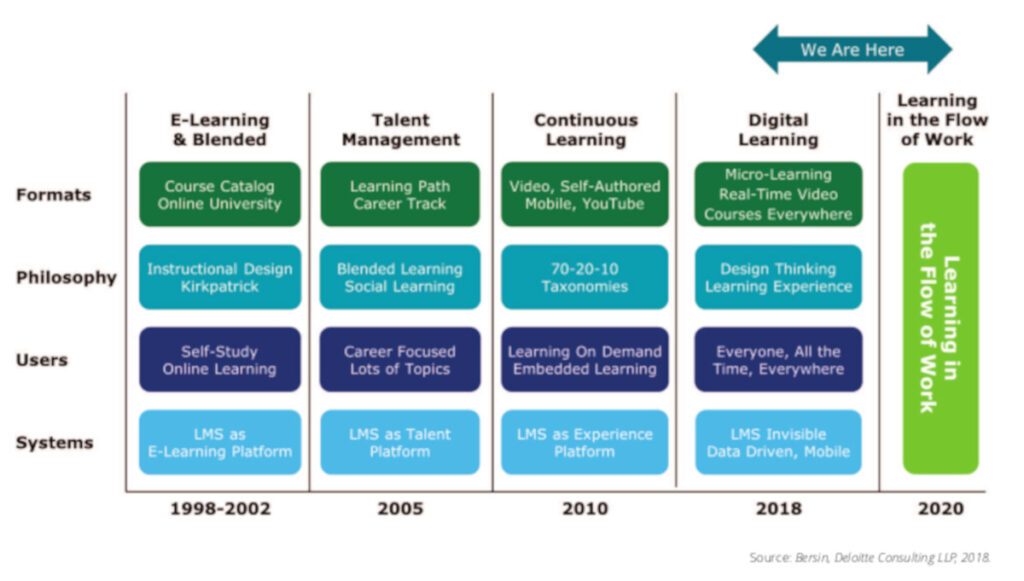Part 3/3
From the Learning Bubble to the Flow of Work
So far, we’ve walked you through the early beginnings of maturity models in academia, all the way to their evolution into a useful tool for L&D. Although we most certainly have not touched on every maturity model that exists, we did want to talk about one more: Dani Johnson’s Enterprise Learning Framework.
Before launching her own consultancy firm, she was at Deloitte with Josh Bersin and worked on the HILO model. When she ventured off on her own, she decided to leverage her in-depth expertise in management science and business consulting to refine the HILO model. Her goal was to link it closer to business reality, aligned with her philosophy for a completely decentralized and personalized L&D that ultimately focuses on its main goal of making business easier.
The Enterprise Learning Framework
Her Enterprise Learning Framework is articulated around four sections, which are then segmented in specific focus areas.
Enterprise Learning Framework
- Section 1: Strategy & Experience
Employee development is owned by the entire organization, not just the L&D function. Business Strategy, Organizational Learning Philosophy and Strategy, Employee Development Experience and Learning Organization Culture are the “conditions” that will either encourage or discourage learning within an organization. Aligning these four focus areas and considering their roles in employee development is crucial to integrating learning with work. - Section 2: Design
Learning Contexts and Infrastructure & Technologies are two focus areas most familiar to L&D practitioners, as they include the contexts for learning (that is, the ways in which employees will learn) and the technologies and infrastructure of learning delivery. The HILO research also identifies Career Progression as an integral focus area that determines how employees learn to master their current roles, as well as how they prepare for their next roles, and all the roles they may fill in the company. - Section 3: Administration & Oversight
The two focus areas in this section are Organization & Governance and Analytics, Measurement and Intelligence. Whereas L&D may have had a high degree of control over employee development decision-making and measurement in the past, these elements in today’s more mature learning organizations are more likely to be governed jointly, and data is more likely to be shared across the business to ensure better employee development decisions. - Section 4: L&D Enabling Capabilities
The HILO study clearly outlines a set of capabilities that L&D should possess in order to support and influence the successful implementation of this framework. These focus areas are: Conditions Creation, Business Skills, Performance Augmentation, Contextualization, Analytics, Design and Delivery.

What about learning outcomes?
Exactly 30 years ago, Peter Senge released his book The Fifth Discipline. In it, he uses an elephant metaphor to illustrate why Systems Thinking is the fifth discipline required to created a Learning Organization (the other four being Shared Vision, Mental Models, Team Learning, and Personal Mastery). The metaphor illustrates that while you could certainly split an elephant in half, you would not end up with two smaller elephants. This was meant to underline the importance of analyzing patterns in an organization from a holistic viewpoint, rather than splitting them into smaller parts just to make them more mangeable.
Even today, learning outcomes are often seen as the elephant in the room. D igital technologies have revolutionized corporate training and give us the means to access all available knowledge at a much lower cost than traditional methods. These new technologies have also increased the speed of delivery. But the true impact of learning remains a grey zone in many places.
While it is important for L&D to demonstrate relevance in the immediate, by promoting and ensuring the scalability and efficiency of existing solutions, it also needs to anticipate the future by regularly questioning the current ways of doing things. This important reflection cannot be limited just to technology and content, or even engagement and usage of the learning platform. Instead, a more systemic approach and a clear strategic framework, viewed through the lens of maturity models, will serve as a steady beacon even during uncertain times. A study published by Fosway last June reported that 59% of L&D leaders described their organization’s adoption of digital learning as immature. Consequently, those organizations were 3 times more likely to have found difficulty coping with the pandemic.